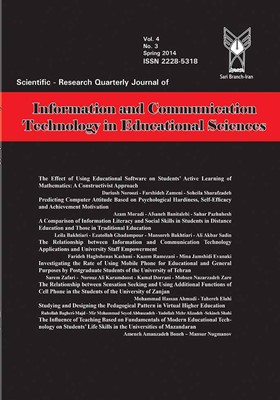بررسی و طراحی الگوی آمادگی پداگوژیکی در نظام آموزش عالی مجازی
الموضوعات :
Infomartion Technology
روح اله باقری مجد
1
,
میرمحمد سیدعباس زاده
2
,
یداله مهرعلیزاده
3
,
سکینه شاهی
4
1 - دانشجوی دکتری مدیریت آموزش عالی، دانشگاه ارومیه
2 - استاد گروه علوم تربیتی، دانشگاه ارومیه
3 - استاد گروه علوم تربیتی، دانشگاه شهید چمران اهواز
4 - استادیار گروه علوم تربیتی، دانشگاه شهید چمران اهواز
تاريخ الإرسال : 24 السبت , ربيع الأول, 1435
تاريخ التأكيد : 27 الجمعة , ذو الحجة, 1434
تاريخ الإصدار : 02 الخميس , رجب, 1435
الکلمات المفتاحية:
آموزش مجازی,
آموزش عالی,
اعضای هیأت علمی,
طراحی الگوی پداگوژیک,
ملخص المقالة :
طراحی الگوی آمادگی پداگوژیک در آموزش عالی مجازی، به منظور ایجاد تمرکز بیشتر، انجام پیشبینی لازم، تدارک و سرمایهگذاری مناسب و تهیه برنامه استراتژیک در سیستم یادگیری، اقدامی لازم و ضروری به نظر میرسد. لیکن هدف پژوهش حاضر، طراحی الگوی آمادگی یاددهی و یادگیری در آموزش عالی الکترونیکی بوده است. این مطالعه در سال تحصیلی 92-1391 به صورت آمیخته (کیفی، کمی) با پرسشنامه محققساخته 29 سؤالی، با پایایی 91/0 اجرا شده است. جامعه تحقیق شامل اعضای هیأت علمی دانشگاه اهواز (517 نفر) بود که از بین آنها، 220 نفر، مطابق جدول کرجسی و مورگان، به صورت تصادفی طبقهای انتخاب شدند. با توجه به تحلیل عاملی اکتشافی و تحلیل توصیفی و محتوایی نتایج حاکی از معنیدار بودن عواملی همچون، مدیریت برنامه و منابع، یادگیرنده محوری، انعطافپذیری و ابزارهای برقراری ارتباط، ارزیابی، روشها و راهبردهای یادگیری، سازماندهی، شیوه طراحی، تحلیل اهداف، تحلیل رسانه، تحلیل یادگیرنده و تحلیل محتوا، اصول، فنآوری، ابزار ارزشیابی،کیفیت مجازی، مدیریت زمان، مدیریت بازار کار، تفکر و اخلاق مجازی، اولویت آموزش و تجارب مجازی بوده است که در یافتهها به صورت الگوی توصیفی ارایه شده است.
المصادر:
Anstead, T., Ginzburg, K., Mike, K., & Belloli, R. (2004). Using technology to further the dine college mission. Michigan: University of Michigan Business School.
Beritain, S., & Liber, O. (2004). A framework for the pedagogical evaluation of e-learning environments. Retrieved Dec 13, 2012, from web-ngram.research. microsoft.com/.../bingbodyjun09_top100kwords.txt
Chickering, A., & Gamson, Z. (1987). Seven principles for good practice in undergraduate education. American Association for Higher Education Bulletin, 39(7), 3-7. Retrieved July 15, 2010, from http://www.aahebulletin.com/public/ archive/sevenprinciples1987.asp
Doherty, W. (2006). An analysis of multiple factors affecting retention in web-based community college courses. The Internet and Higher Education, 9(4), 245-255.
Groff, J., & Mouza, C. (2008). A framework for addressing challenges to classroom technology use. AACE Journal, 16(1), 21-46.
Gulati, S. (2008). Technology-enhanced learning in developing nations: A review. International Review of Research in Open and Distance Learning, 9(1), 1-16.
Hall, M. (2001). Realizing the Virtual Hamburge. Retrieved Dec 13, 2012, from http://www.chet.org.zal
Houseinilorgani, S. M., Mirarabrazei, R., & Rezaei, S. (2008). An investigation of obstacles in development of E-learning in Iran educational system. Journal of Planning and Management in Educational System, 1(1), 47-59. (in Persian).
Jahangrd, A. (2003). Global education in transition. Proceedings of E-Learning Conference. Tehran, Iran: Institution of Higher Education Planning. Retrieved Dec 13, 2012, from: http://icelet2012.ut.ac.ir/ (in Persian).
Khan, B. (2005). E-Learning QUICK Checklist. George Washington University, USA.
Levy, Y. (2007). Comparing dropouts and persistence in e-learning courses. Computers & Education, 48(2), 185-204.
Liyan, S, Emise, S, Janette, R., & Hill Myung, H. K. (2004). Improving online learning: Student perceptions of useful and challenging characteristics. Internet and Higher Education, 7(1), 59-70.
Masiello, I., Ramberg, R., & Lanka, K. (2005). Attitudes to the application of a web-based learning system in a microbiology course. Computers & Education, 45(3), 171-185.
McMurray, A. J. (2007). College students, the GI Bill, and the proliferation of online learning: A history of learning and contemporary challenges. The Internet and Higher Education, 10(2), 143-150.
Nancy, L., & Onwuegbuzie, A. J. (2009). A typology of mixed methods research designs. Qual Quant, 43(2), 265-275.
Nichols, A. J., & Levy, Y. (2009). Empirical assessment of college student-athletes' persistence in e-learning courses: A case study of a U.S. National Association of Intercollegiate Athletics (NAIA) institution. Internet and Higher Education, 12(1), 14-25.
Razzaghei, S. (2006). Factors affecting the development of virtual universities in Iran and its strategic status. Master's Thesis, School of Management, Tehran University. (in Persian).
Saleamabadei, S. (2006). An investigation of obstacles in development of e-learning in Iran. Master's Thesis, Management Faculty of Tehran University. (in Persian).
Sarkaranei, M., & Moghaddam, A. (2003). Web-based learning and innovation in distance education. Journal of Educational Innovation, 2(3), 77-108. (in Persian).
Shea, P., Pickett, A., & Sauli, C. (2005). Increasing access to higher education: A study of the online teaching among 913 college faculty. International Review of Research in Open and Distance Learning, 6(2). Retrieved from http://www.irrodl.org/index.php/irrodl/article/view/238/493
Siragusa, L. P. (2005). Identification of effective instructionaldesign principles and learning strategies for students studying in webbasedlearning environments in higher education. Doctoral Dissertation in Education, Curtin University of Technology.
Vonderwell, S. (2003). An examination of asynchronous communication experiences and perspectives of students in an online course: A case study. Internet and Higher Education, 6(1), 77-90.
Zareii Zavaraki, E. (2008). Measurement and evaluation of e-learning. Journal of Higher Education, 3(3), 73-88. (in Persian).
Zoulfagharei, M., Mehrdad, N., Parsayekta, Z., Salmaneibaroughei, N., & Bohranei, N. (2007). Both methods of training and lectures on e-learning course on maternal and child health nursing students. Iranian Journal of Medical Education, 7(1), 31-39. (in Persian).


